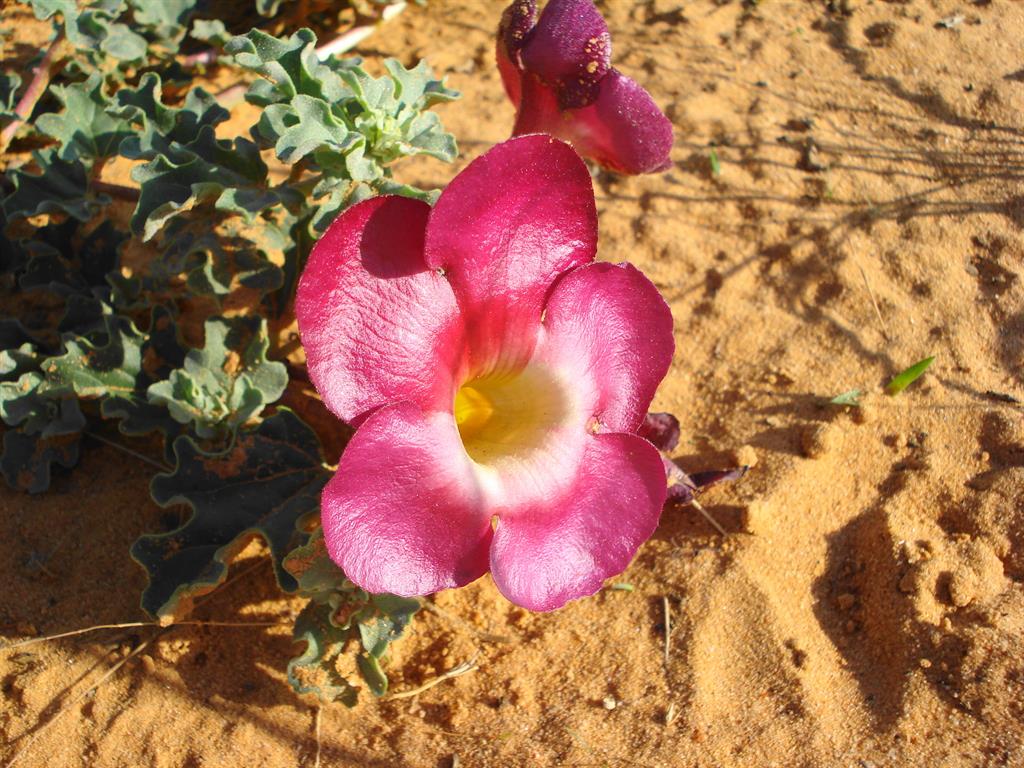The devil’s claw
Luise Hoffmann
During the Herero and Nama uprising of 1904 - 1906 Gottfried .H. Mehnert, an officer of the “Kaiserliche Schutztruppe”, observed that a seriously wounded Nama man, who could not be successfully treated by the doctors, was cured by a traditional healer. Intrigued by this success, Mehnert tried to find out, which plants had been used. However, the healer did not divulge his secret and Mehnert, with the help of his hunting dog eventually found the hole where the healer had dug up the tubers of devil’s claw (Harpagophytum procumbens) and the separate place where the he had buried the foliage to protect his secret from Mehnert.
At the conclusion of the uprising Mehnert settled on his farm Nababis near Mariental where he continued to study the devil’s claw. During the first world war Mehnert himself became seriously ill. The two only doctors in Windhoek at the time could not help him, but he resorted to using devil’s claw and recovered. Consequently he proceeded to harvest and process the plant under the name Harpago tea and to market it on a small scale
In 1953 devil’s claw (Harpagophytum procumbens) was introduced to Europe by Prof OH Volk from the University of Würzburg who he was instrumental in having the medicinal properties of the plant investigated and certified. It proved to be particularly effective in treating arthritis and rheumatism, apparently working like cortisone but without the detrimental side effects of that drug. It also has analgesic, sedative and diuretic properties. Most studies involve chronic use, rather than acute treatment of pain. This herbal drug is also mentioned officially in the European Pharmacopoeia.
Harvesting is usually carried out by very poor people who have no other source of income. The plant consists of a main root and several storage tubers and can grow as deep as 2 m. So a deep hole has to be dug, taking care not to damage the main root, otherwise the plant will die. Only about half of the storage tubers may be harvested. Subsequently the hole must be closed so that the plant can regenerate to be harvested again during the next season.
For further processing the roots are sliced thinly by hand, dried in the shade and packed in bags. They are hygroscopic and inclined to get mouldy. Therefore it is important to dry them extremely well. The dried material only constitutes 10% of the original weight.
During the Herero and Nama uprising of 1904 - 1906 Gottfried .H. Mehnert, an officer of the “Kaiserliche Schutztruppe”, observed that a seriously wounded Nama man, who could not be successfully treated by the doctors, was cured by a traditional healer. Intrigued by this success, Mehnert tried to find out, which plants had been used. However, the healer did not divulge his secret and Mehnert, with the help of his hunting dog eventually found the hole where the healer had dug up the tubers of devil’s claw (Harpagophytum procumbens) and the separate place where the he had buried the foliage to protect his secret from Mehnert.
At the conclusion of the uprising Mehnert settled on his farm Nababis near Mariental where he continued to study the devil’s claw. During the first world war Mehnert himself became seriously ill. The two only doctors in Windhoek at the time could not help him, but he resorted to using devil’s claw and recovered. Consequently he proceeded to harvest and process the plant under the name Harpago tea and to market it on a small scale
In 1953 devil’s claw (Harpagophytum procumbens) was introduced to Europe by Prof OH Volk from the University of Würzburg who he was instrumental in having the medicinal properties of the plant investigated and certified. It proved to be particularly effective in treating arthritis and rheumatism, apparently working like cortisone but without the detrimental side effects of that drug. It also has analgesic, sedative and diuretic properties. Most studies involve chronic use, rather than acute treatment of pain. This herbal drug is also mentioned officially in the European Pharmacopoeia.
Harvesting is usually carried out by very poor people who have no other source of income. The plant consists of a main root and several storage tubers and can grow as deep as 2 m. So a deep hole has to be dug, taking care not to damage the main root, otherwise the plant will die. Only about half of the storage tubers may be harvested. Subsequently the hole must be closed so that the plant can regenerate to be harvested again during the next season.
For further processing the roots are sliced thinly by hand, dried in the shade and packed in bags. They are hygroscopic and inclined to get mouldy. Therefore it is important to dry them extremely well. The dried material only constitutes 10% of the original weight.






Kommentar
Allgemeine Zeitung
Zu diesem Artikel wurden keine Kommentare hinterlassen